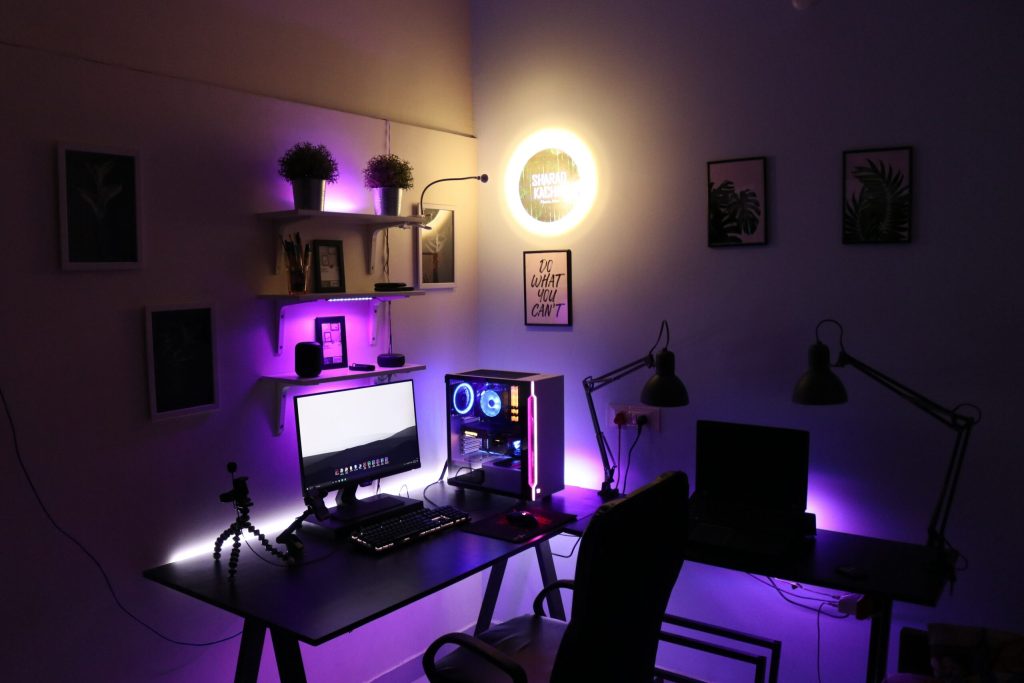Setting up your gaming setup at home is an exciting project that allows you to create a space tailored to your gaming preferences. Here’s a step-by-step guide to help you create the ultimate gaming setup:
1. Choose the Right Location
- Room Selection: Pick a room or area in your home that offers enough space for your gaming setup. Ideally, it should be quiet, well-ventilated, and free from distractions.
- Lighting Consideration: Ensure the room has good natural lighting, but also consider blackout curtains to control light during gameplay. Avoid screen glare by positioning your setup away from direct sunlight.
2. Select a Gaming Desk
- Size: Choose a desk that fits your space while providing ample room for your monitors, keyboard, mouse, and other accessories. An L-shaped desk is great if you need extra surface area.
- Material: Opt for a sturdy desk that can support your gear. Desks made from metal, wood, or high-quality MDF are good options.
- Cable Management: Select a desk with built-in cable management features to keep wires organized and out of sight.
3. Invest in a Comfortable Gaming Chair
- Ergonomics: Your chair should provide lumbar support, adjustable armrests, and a headrest. The ability to recline is a bonus for those long gaming sessions.
- Material: Choose between fabric, which is breathable, or leather, which is easier to clean and looks sleek.
4. Set Up Your Monitors
- Single or Multiple Monitors: Decide if you want a single ultrawide monitor for a better experience or a dual/triple monitor setup for multitasking.
- Mounting: Use monitor arms to save desk space and adjust the monitor height for better ergonomics. Ensure the top of the monitor is at or slightly below eye level.
- Positioning: Place the monitors about an arm’s length away, centered with your chair for optimal viewing.
5. Configure Your PC or Console
- Positioning: Place your gaming PC or console in a well-ventilated area to prevent overheating. Use a vertical stand if space is tight.
- Cable Management: Use Velcro straps, cable sleeves, or under-desk trays to keep your cables organized and reduce clutter.
6. Optimize Your Peripherals
- Mechanical Keyboard: Choose a keyboard with mechanical switches for better tactile feedback. Look for models with customizable RGB lighting and programmable keys.
- Gaming Mouse: Select a gaming mouse with adjustable DPI settings, extra buttons, and a comfortable grip. Pair it with a large mouse pad for unrestricted movement.
- Headset: Invest in a quality gaming headset with surround sound and noise-canceling features for clear communication and audio.
7. Enhance with Audio and Visual Accessories
- Speakers: If you prefer external speakers, choose a set with a subwoofer for deep bass. Position them to create an optimal soundstage.
- Headset Stand: Keep your headset organized with a stand that may also offer additional USB ports or RGB lighting.
- RGB Lighting: Add RGB light strips behind your desk or monitor to create a better ambiance. Sync the lights with your game for a more dynamic experience.
8. Add Comfort and Personalization
- Desk Mat: Use a large desk mat that covers your keyboard and mouse area. Choose one with a design or color that complements your gaming theme.
- Decor: Personalize your space with gaming posters, wall art, or collectibles that reflect your favorite games and characters.
- Plants: Incorporate small plants to add a touch of greenery and freshness to your setup.
9. Set Up Streaming Gear (Optional)
- Webcam: Position a quality webcam on top of your monitor for streaming or video calls.
- Microphone: Use a standalone microphone with a pop filter for clear audio if you plan to stream or record gameplay.
- Lighting: Set up a ring light or softbox lighting to ensure your face is well-lit during streams.
10. Organize and Maintain
- Storage: Use wall-mounted shelves, drawers, or cabinets to store games, controllers, and accessories.
- Cleaning: Regularly dust and clean your setup to keep it in top condition. Pay special attention to your screens and peripherals.
- Upgrades: Keep your setup flexible for future upgrades, whether it’s adding new peripherals or upgrading your PC components.
Conclusion
Once everything is in place, take time to fine-tune the setup according to your preferences. Make adjustments to monitor height, chair positioning, and lighting until your setup feels comfortable and optimized for gaming. Whether you’re into competitive gaming or casual play, your customized gaming setup will enhance your overall experience and provide a space you’ll love spending time in.

